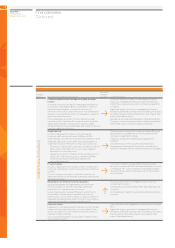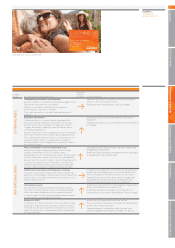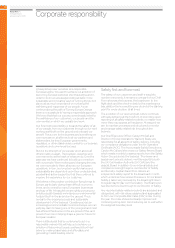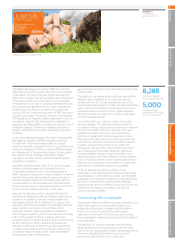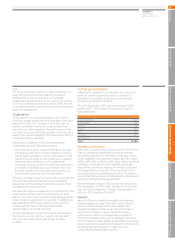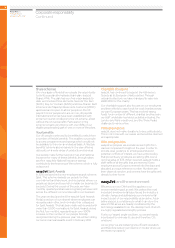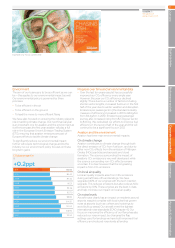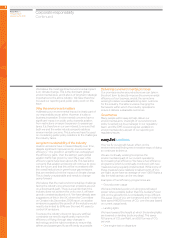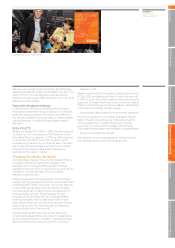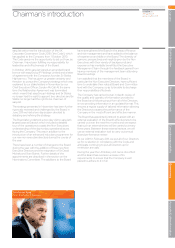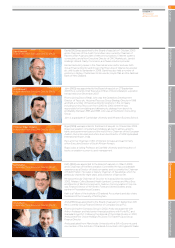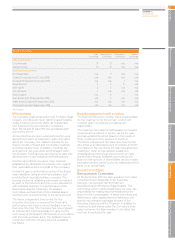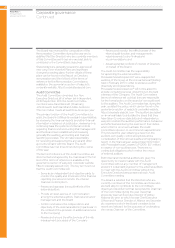EasyJet 2011 Annual Report Download - page 40
Download and view the complete annual report
Please find page 40 of the 2011 EasyJet annual report below. You can navigate through the pages in the report by either clicking on the pages listed below, or by using the keyword search tool below to find specific information within the annual report.
38
Corporate responsibility
Continued
easyJet plc
Annual report
and accounts 2011
We believe the most significant environmental impact
is on climate change. This is the dominant global
environmental issue, and it also is of long-term strategic
importance to the airline industry. We have therefore
focused our reporting and public policy work on this
issue.
Why the environment matters
Addressing our environmental impact is clearly part of
our responsibility as an airline. However, it is also a
business imperative. Environmental concerns have a
significant impact on public policy towards aviation,
from restrictions on airport expansion to passenger
taxes. It is therefore in our own interest to ensure that
both we and the wider industry properly address
environmental concerns. This is why we have focused
on considering public policy solutions to the challenges
the industry faces.
Long-term sustainability of the industry
Aviation emissions have increased steadily over time,
despite significant improvement in environmental
efficiency – the growth in air traffic has outweighed
the efficiency gains. Over the last ten years global
aviation traffic has grown by over 5% a year, while
efficiency gains have been about 2%. This has led to
concerns that aviation emissions will continue to grow
into the future, and that this will be inconsistent with
the overall reductions in greenhouse gas emissions
thatare needed to limit the impact of climate change.
This is clearly unsustainable and needs to change
goingforward.
We believe that the main environmental key challenge
facing the industry is to ensure that emissions are put
on a downwards path. There is a real risk that if the
industry does not achieve this on its own, it will have
growth constraints placed on it. We have already seen
suggestions of this in the UK, where the Committee
onClimate in its December 2009 report on aviation
emissions suggested the growth of the industry would
need to be limited to 60% over the next 40 years to
control UK emissions.
To ensure the industry does not face any artificial
constraints we need to significantly improve the
efficiency of flying, through step-changes in
technology, and the right incentives to ensure that
airlines and passengers fly as efficiently as possible.
Delivering our environmental promises
Our promises revolve around actions we can take in
theshort term to directly improve the environmental
efficiency of our business, and at the same time
working to deliver a sustainable long-term outcome
forthe industry. The latter involves changing the
framework within which the industry operates to
ensure it delivers sustainable outcomes.
Governance
Many people within easyJet help deliver our
environmental aims. Oversight of our environment
policy is carried out by a manager in our regulatory
team, and the EMT receives regular updates on
environmental policy as part of our reporting on
regulatory issues.
easyJet’s actions
How we fly our aircraft has an effect on the
environment and finding new innovative ways of doing
so continues to drive us.
We are continually working to improve the
environmental impact of our current operations,
byincreasing fuel efficiency. We have a fuel efficiency
programme which is continually monitored, with new
measures being regularly implemented. While some of
these measures save relatively small amounts of CO2
per flight, as we have an average of over 1,000 flights a
day the total savings can be very large.
Examples of fuel efficiency programmes are:
– Ground power usage
We have instituted a policy of using ground based
power where possible (rather than the Auxiliary Power
Unit on the aircraft); this is considerably more efficient.
This saves 13 kg of CO2 per turnaround, and in total we
have saved 44,000 tonnes of CO2 over the year based
on current usage levels.
– Landing lights
We have lowered the height at which the landing lights
are lowered on landing (reducing drag). This saves
150grams of CO2 per flight, and 550 tonnes of CO2
peryear.
– One engine taxi on departure


